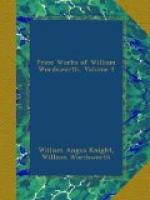Among the benefits arising, as Mr. Coleridge has well observed, from a Church Establishment of endowments corresponding with the wealth of the country to which it belongs, may be reckoned as eminently important, the examples of civility and refinement which the Clergy stationed at intervals, afford to the whole people. The Established clergy in many parts of England have long been, as they continue to be, the principal bulwark against barbarism, and the link which unites the sequestered peasantry with the intellectual advancement of the age. Nor is it below the dignity of the subject to observe, that their taste, as acting upon rural residences and scenery often furnishes models which country gentlemen, who are more at liberty to follow the caprices of fashion, might profit by. The precincts of an old residence must be treated by ecclesiastics with respect, both from prudence and necessity. I remember being much pleased, some years ago, at Rose Castle, the rural seat of the See of Carlisle, with a style of garden and architecture, which, if the place had belonged to a wealthy layman, would no doubt have been swept away. A parsonage-house generally stands not far from the church; this proximity imposes favourable restraints, and sometimes suggests an affecting union of the accommodations and elegances of life with the outward signs of piety and mortality. With pleasure I recall to mind a happy instance of this in the residence of an old and much-valued Friend in Oxfordshire. The house and church stand parallel to each other, at a small distance; a circular lawn or rather grass-plot, spreads between them; shrubs and trees curve from each side of the dwelling, veiling, but not hiding, the church. From the front of this dwelling, no part of the burial-ground is seen; but as you wind by the side of the shrubs towards the steeple-end of the church, the eye catches a single, small, low, monumental headstone, moss-grown, sinking into, and gently inclining towards the earth. Advance, and the churchyard, populous and gay with glittering tombstones, opens upon the view. This humble and beautiful parsonage called forth a tribute, for which see the seventh of the ‘Miscellaneous Sonnets,’ Part III.
357. Rush-bearing. [Sonnet XXXII.]
This is still continued in many churches in Westmoreland. It takes place in the month of July, when the floor of the stalls is strewn with fresh rushes; and hence it is called the ‘Rush-bearing.’
358. George Dyer.
‘Teaching us to forget them or forgive.’ [Sonnet XXXV. l. 10.]
This is borrowed from an affecting passage in Mr. George Dyer’s History of Cambridge.
359. Apprehension.
——’had
we, like them, endured
Sore stress of apprehension.’
[Sonnet XXXVII. l. 6.]
See Burnet, who is unusually animated on this subject; the east wind, so anxiously expected and prayed for, was called the ‘Protestant wind.’




